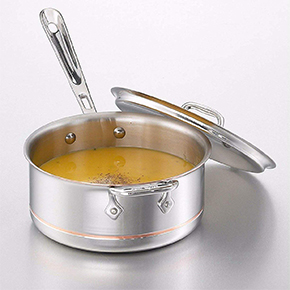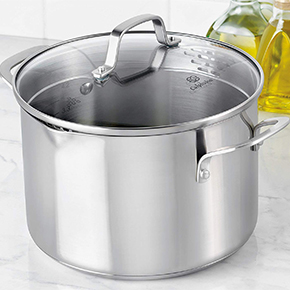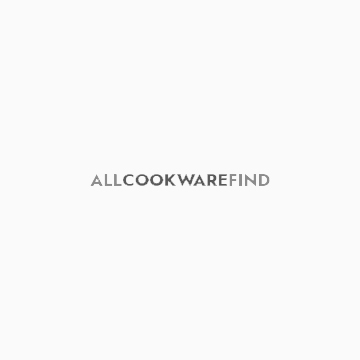Stainless-steel cookware is timeless and worth buying. It is versatile for many cooking techniques and durable enough for years long.
Having good stainless-steel cookware means a worthwhile investment in every kitchen. It’s good for most culinary tasks, easy to use and care and offers wide ranges of piece assortment, and last for years long.
Stainless steel is by far a most common material because of many strong advantages and value accent — It’s durable, high-heat resistant, non-reactive, very durable, easy to care, dishwasher-safe, rust-and scratch-resistant to rust and beautifully shiny.
The big point is the good stainless-steel pans — fully-clad — do excellent jobs for searing and sautéing. They can produce beautiful brown and delicious flavor through Maillard reaction like cast-iron pans but have no concerns about acidic-foods reaction.
Moreover, as these pans stand up to high heat (mostly up to 500°F), they can go from stovetop to oven or broiler.
Stainless-steel is a poor heat conductor all by itself — slowly and unevenly temperature changes. So, it needs to add other conductive materials, which commonly are aluminum or copper or both, to enhance heat absorption and evenness, and help building sturdier construction.
By construction, there are three types of stainless-steel cookware:

Fully-Clad
The ideal option. It has a conductive material layer(s) inside, or the ‘core’, extends up to from the bottom to the sides of the pots and pans to significantly improve cooking performance. Sometimes, it’s called ‘Multi-Ply’ — Tri-Ply means 3 layers of metals.
Pro: Provide excellent heat ability, very evenly heat and less food scorch. The results depend on how thick and number layers of conductive materials. Some well-constructed pans, like All-Clad and Mauviel, can deliver superb sears like a cast-iron pan.
Con: Expensive. It tends to heavier but durable than others.

Encapsulated Base
The second-best option. It has a heat-transferred material only in the bottom of the pan, not runs to the sides. You also find some other names: encapsulated disc, aluminum disc or bottom clad.
Pro: Provide acceptably good heat ability and less hot spots but inferior than fully-clad version. Recommended for stockpot. Attractively less price and weight for beginners and budget-tight people.
Con: Not good for oven roasting, searing and browning. Food sticks.

No Conductor
The worst option. This can be found in cheap cookware. Mostly, it has thin and light construction and provides poor heat absorption and uneven, and hard to clean.
Don’t recommend at any case because of poor performance, flimsy construction and ugly discoloration — not worth buying at all.
What do 18/0, 18/8 and 18/10 numbers mean?
As known, stainless steel is a metal alloy consisting chromium and several other metals, nickel included. These number are chromium/nickel ratio. The first number 18 means it has 18% of chromium content and 10% of nickel portion.
Chromium boosts durability and protects stainless-steel from stains and rust, while nickel makes chromium more robust and glossier. As the result, the higher nickel share, the more durable and shinier the cookware is.
Unless you have nickel allergy, buy 18/10 stainless-steel cookware.
Does the 304 stainless-steel mean anything to the pan?
Stainless-steel must have a minimum 10.5% by weight of chromium. High quality products contain anywhere from 18-20% chromium. These are steel grades that are used in cookware:
Stainless-steel cookware is generally considered as a safe material for cookware. It’s not react to acidic or alkaline foods. You can have peace of mind that it won’t harshly leach some toxins like copper or aluminum, release harmful fumes like Teflon or easily break like glass every time you cook with high heat or make tomato sauces.
Still, everything has excerption. As stainless-steel is alloy, which consists of iron, nickel and chromium, there might raise possible health concerns from metal toxicity, as well. According to WHFoods.org, it mildly leaches small amount of metal to cause severe effect. Unless you’re using poor quality, damaged cookware or have nickel allergenic, it’s concerned safe to use. For detailed safety issues, see Stainless-steel and food safety.
When choosing good cookware, these are universal checklists before buying:
Since stainless cookware is nothing new that doesn’t need extraordinary technologies, the construction, type of conductors and quality of material have huge impact to price.
Commonly, a set of normal-sized (10 to 12 pieces) can vary from $70 to $2,000. The more layers, higher conductive materials, the steeper price — The 18/10 full-clad is the most expensive. For instance, the All-Clad Copper Core, the 5-ply bonded construction with stainless steel, aluminum and a thick copper core, costs around $1,200 - 1,400* for a set. However, buying good cookware is an investment rather than extravagant as it will offer the excellent cooking quality for decades later.
Still, if your budget is limited, look for a thick encapsulated aluminum base with quality 18/10 stainless-steel to ensure quality, like a 10-piece set of Cuisinart Chef’s Classic is under $150*.
*Retail price at date of reviewing.
Typically, stainless-steel cookware fit for most tasks and have wide piece assortments, from tongs to pressure cookers. However, these are aptly recommended for stainless tools:
The good news is stainless-steel is easier to maintain — it might get burnt cruds, badly scorches or even discoloration, but you can bring it shine again with the proper care. Also, it’s indestructible for scrubbing or putting in the dishwasher.
For daily clean, you just handle it with soapy water and non-scratchy scrubber. Leave it cold before washing to prevent the pan from warp and dent. If the scorch pan still has stubborn stains, bring it boil before washing again.
If you have cleaning problems, see our workable guides to clean and keep your stainless-steel look new.